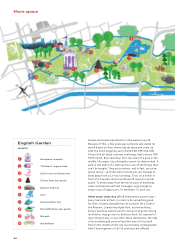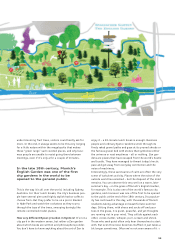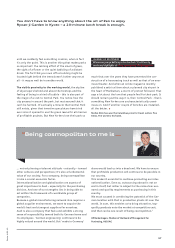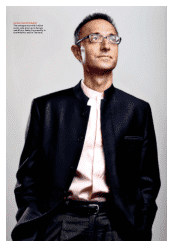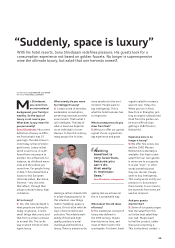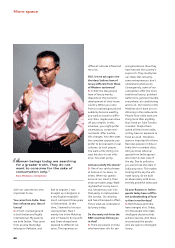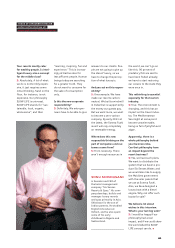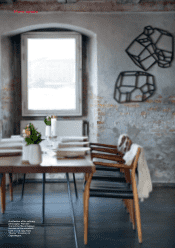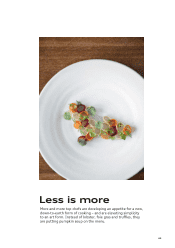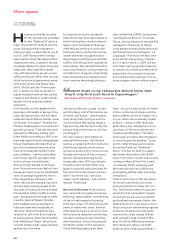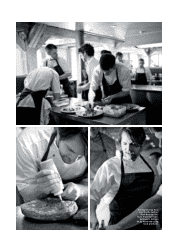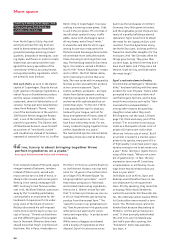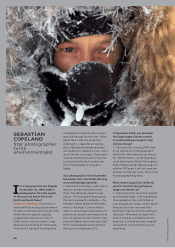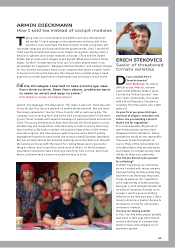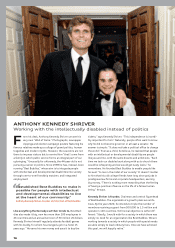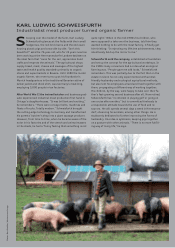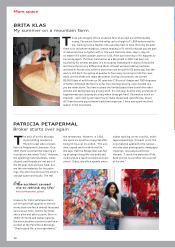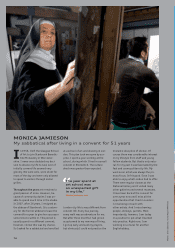Audi 2009 Annual Report Download - page 67
Download and view the complete annual report
Please find page 67 of the 2009 Audi annual report below. You can navigate through the pages in the report by either clicking on the pages listed below, or by using the keyword search tool below to find specific information within the annual report.More space
64
e came up with the storyline
for the international animated
hit film “Ratatouille” and is a
major role model for chefs all over the
world. But anyone who manages to
reserve a highly coveted table at one of
top U.S. chef Thomas Keller’s restau-
rants needs to steel themselves before
studying the menu. Instead of the usu-
al prestige dishes of a classic three-star
restaurant, they might find mussel
stew with bacon being served, or even
coffee and donuts. Keller, who runs two
of the six top-rated gastronomic estab-
lishments in the United States, New
York’s “Per Se” and the “French Laun-
dry” in California, likes to transform
typical everyday American fare such as
macaroni and cheese or cashew butter
and jam into an exquisite culinary
experience.
Until recently, such escapades would
have been unthinkable in Europe. Previ-
ously, the typical menu of a star-rated
restaurant had to feature lobster, caviar
or foie gras. The reason? “Because the
Michelin Guide expects us to use French
gourmet products.” That was the blunt
explanation offered by leading chef
Dieter Müller as recently as 2007 to ex-
plain why, apart from the Königsberger
Klopse meat balls with deep-fried ca-
pers on his renowned amuse-bouche
menu at Schlosshotel Lerbach in Ber-
gisch Gladbach, “unfortunately there
aren’t many regional specialties that
work in a three-star restaurant.”
Quite a lot has changed in the mean-
time. More and more top chefs all over
Europe are overturning the established
canon of prestige ingredients. And in
their vanguard are Germany’s elite
chefs, who are developing a repertoire
of home-style cooking capable at the
very least of holding its own alongside
the inevitable lobster, truffle and foie
gras – and prepared with superb crafts-
manship: Joachim Wissler from Ber-
gisch Gladbach puts a new slant on
lobscouse stew and cheesecake; at
“Sonnora” Helmut Thieltge serves a
variation on calf’s liver Berlin-style as
an amuse-gueule, while Sven Elverfeld
from Wolfsburg’s “Aqua” dares to put
cod with mixed pickles, sauté potatoes
and bacon on the menu.
It is important to point out that all
these dishes bear little resemblance to
the rib-sticking fare on which they are
based, and in the hands of these top
chefs they are certainly on a par with
the haute cuisine old favorites such as
lobster thermidor and glazed blood-
stewed pigeon with foie gras and Alba
truffles. Even though their ingredients
seem simpler, they demand at least as
much concentration, culinary expertise,
and dedication to prepare. Assembling
them sometimes even demands much
more creativity than simply shaving a
100-euro truffle onto a plate – as Hol-
ger Stromberg, chef of the German soc-
cer team, well knows: “Unfortunately,
most young chefs coming to work for
me still assume that quality means a
high price tag. But the more costly the
produce they are let loose on, the slop-
pier they get.”
The main reason is the tradition of
chasing Michelin stars. The Michelin
Guide is an esteemed French institution
that focuses squarely on the cuisine
and luxury produce of its home country.
The gourmet branch of the tire manu-
facturer has been awarding its leg-
endary stars since 1926, according to
the same time-honored model, as a
guide to motorists with a penchant for
fine food: Three stars means a restau-
rant is “worth the trip,” two stars
means “worth a detour,” and one star
rates as “interesting.”
But even in the home of the connois-
seur, more and more gastronomes are
becoming “gastrosophes” and rejecting
all the toil and anguish of pursuing
three stars in favor of rediscovering the
pearls of traditional cuisine. Some of
them have even gone so far as to close
down a starred restaurant so that they
can start cooking precisely what they
want elsewhere, without the pressure.
The Breton master of fish and spices
Olivier Roellinger gave up his three
stars in November 2008, closing down
“Les Maisons de Bricourt” in Cancale,
France, held by many to be the best fish
restaurant in the world, so that he
could prepare similar dishes without all
the fuss at his second restaurant, “Le
Coquillage.” His fellow chef Alain Alex-
anian sold his star-winning “L’Alexan-
drin” in Lyon, France, in 2007 and has
since been touring regional producers
to research old recipes and methods of
preparation. He is using this lost and
now rediscovered knowledge in his ca-
pacity as gastro advisor with an organic
slant – for such clients as the “Hi Hotel”
in Nice, on the French Riviera, and the
public cafeteria of the St. Joseph Clinic
in Lyon, which uses exclusively organic
produce. “I want to offer the young
generation a new, healthy form of cui-
sine that is in harmony with the envi-
ronment and affordable.” The latter
motive also prompted Alain Senderens
to close his gourmet paradise, “Lucas
Carton,” after 28 years and to reposi-
tion himself with the “Senderens”
bistro: “I’ve lost my faith in a system
that leaves diners with a bill of 400
euros. From now on I want to do simple
cooking, without all the frills. I want
a restaurant that is in keeping with
the times but which still offers very
good quality and has a few surprising
innovations.”
There is much more to this new desire
for simple cuisine than just a resur-
gence of what the Germans call “lux-
ese,” that modish blend of luxury and
asceticism that culminated in tawdry
concoctions such as curry wurst with
gold leaf and champagne. Rather, the
latest penchant for new luxury is more
likely to focus on transforming regional
products into delicacies using haute
cuisine skills: chops instead of Kobe
beef, and calf’s head instead of foie
gras. For all the differences between
their dishes and tastes, one belief
above all unites leading gourmands
“
Whoever dines in my restaurant should know that
they’ll only find such food in Copenhagen.”
René Redzepi, Michelin-starred chef in Copenhagen
COPY/PETER WAGNER
PHOTOS/DITTE ISAGER
H


